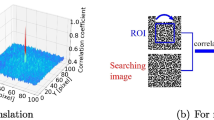Abstract
Shape-from-shading (SFS) aims to reconstruct the three-dimensional shape of an object from a single shaded image. This article proposes an improved framework based on belief propagation for computing SFS. The implementation of the well-known brightness, integrability and smoothness constraints inside this framework is shown.
We implement the constraints as probability density functions. For example, the brightness constraint is a two-dimensional probability density function that relates all possible surface gradients at a pixel to their probability given the pixel intensity. A straightforward extension of the framework to photometric stereo is presented, where multiple images of the same scene taken under different lighting conditions are available.
The results are promising, especially since the solution is obtained by iteratively applying simple operations on a regular grid of points. The presented framework therefore can be implemented in parallel and is a reasonably likely biological scheme.
Similar content being viewed by others
References
Belhumeur, P. N., Kriegman, D. J., & Yuille, A. L. (1999). The bas-relief ambiguity. International Journal of Computer Vision, 35(1), 33–44.
Bichsel, M., & Pentland, A. (1992). A simple algorithm for shape from shading. Computer Vision and Pattern Recognition, 92, 459–465.
Brooks, M. J., & Horn, B. K. P. (1985). Shape and source from shading. In Proceedings of the 9th international joint conference on artificial intelligence (Vol. II, pp. 932–936). Los Angeles, California, USA.
Fan, J., & Wolff, L. B. (1997). Surface curvature and shape reconstruction from unknown multiple illumination and integrability. Computer Vision and Image Understanding, 65(2), 347–359.
Frankot, R. T., & Chellappa, R. (1988). A method for enforcing integrability in shape from shading algorithms. IEEE Transactions on Pattern Analysis and Machine Intelligence, 10(4), 439–451.
Heskes, T., Albers, K., & Kappen, B. (2003). Approximate inference and constrained optimization. In Uncertainty in artificial intelligence 2003. San Fransisco: Morgan Kaufmann.
Horn, B. K. P. (1990). Height and gradient from shading. International Journal of Computer Vision, 5(1), 37–75.
Horn, B. K. P., & Brooks, M. J. (1986). The variational approach to shape from shading. Computer Vision, Graphics, and Image Processing, 33(2), 174–208.
Horn, B. K. P., & Brooks, M. J. (Eds.). (1989). Shape from shading. Cambridge: MIT Press.
Ikeuchi, K., & Horn, B. K. P. (1981). Numerical shape from shading and occluding boundaries. Artificial Intelligence, 17(1–3), 141–184.
Kimmel, R., & Sethian, J. A. (2001). Optimal algorithm for shape from shading and path planning. Journal of Mathematical Imaging and Vision, 14(3), 237–244.
Kschischang, F., Frey, B., & Loeliger, H. (2001). Factor graphs and the sum-product algorithm. IEEE Transactions on Information Theory, 47, 498–519.
Oliensis, J., & Dupuis, P. (1991). Direct method for reconstructing shape from shading. In B.C. Vemuri (Ed.), Geometric methods in computer vision, Proceedings of the Society of Photo-Optical Instrumentation Engineers (SPIE) conference. Proc. SPIE, 1570, 116–128.
Onn, R., & Bruckstein, A. (1990). Integrability disambiguates surface recovery in two-image photometric stereo. International Journal of Computer Vision, 5(1), 105.
Pentland, A. (1984). Local shape analysis. IEEE Transactions on Pattern Analysis and Machine Intelligence, 170–187.
Pentland, A. (1988). Shape information from shading: a theory about human perception. In Proceedings of the 2nd IEEE international conference on computer vision (pp. 404–413).
Petrovic, N., Cohen, I., Frey, B. J., Koetter, R., & Huang, T. S. (2001). Enforcing integrability for surface reconstruction algorithms using belief propagation in graphical models. In Proceedings of the conference on computer vision and pattern recognition (Vol. 1, p. 743).
Potetz, B. (2007). Efficient belief propagation for vision using linear constraint nodes. In Proceedings of the conference on computer vision and pattern recognition.
Ragheb, H., & Hancock, E. R. (2003). Darboux smoothing for shape-from-shading. Pattern Recognition Letters, 24(1–3), 579–595.
Sethian, J. A. (1999). Fast marching methods. SIAM Review, 41(2), 199–235.
Shon, A. P., & Rao, R. P. (2005). Implementing belief propagation in neural circuits. Neurocomputing, 65-66, 393–399.
Strat, T. M. (1979). A numerical method for shape-from-shading from a single image. Master’s thesis, Department of Electrical Engineering and Computer Science, Massachusetts Institute of Technology, Cambridge, MA, USA.
Tankus, A., Sochen, N., & Yeshurun, Y. (2005). Shape-from-shading under perspective projection. International Journal of Computer Vision, 63(1), 21–43.
Tsai, P.-S., & Shah, M. (1994). Shape from shading using linear approximation. Image and Vision Computing, 12(8), 487–498.
Woodham, R. J. (1989). Photometric method for determining surface orientation from multiple images. In Shape from shading (pp. 513–531). Cambridge: MIT Press.
Worthington, P. L., & Hancock, E. R. (1999). New constraints on data-closeness and needle map consistency for shape-from-shading. IEEE Transactions on Pattern Analysis and Machine Intelligence, 21(12), 1250–1267.
Wu, T.-P., & Tang, C.-K. (2005). Dense photometric stereo using a mirror sphere and graph cut. In IEEE Computer Society conference on computer vision and pattern recognition (pp. 140–147).
Yuille, A. (2001). An algorithm to minimize the Bethe free energy. In Proceedings of the third international workshop on energy minimization methods in computer vision and pattern recognition (EMMCVPR 2001), Sophia Antipolis, France, 3–5 September 2001. Berlin: Springer.
Zhang, R., Tsai, P.-S., Cryer, J. E., & Shah, M. (1999). Shape from shading: a survey. IEEE Transactions on Pattern Analysis and Machine Intelligence, 21(8), 690–706.
Zheng, Q., & Chellappa, R. (1991). Estimation of illuminant direction, albedo, and shape from shading. IEEE Transactions on Pattern Analysis and Machine Intelligence, 13(7), 680–702.
Author information
Authors and Affiliations
Corresponding author
Rights and permissions
About this article
Cite this article
Wilhelmy, J., Krüger, J. Shape from Shading Using Probability Functions and Belief Propagation. Int J Comput Vis 84, 269–287 (2009). https://doi.org/10.1007/s11263-009-0236-y
Received:
Accepted:
Published:
Issue Date:
DOI: https://doi.org/10.1007/s11263-009-0236-y




